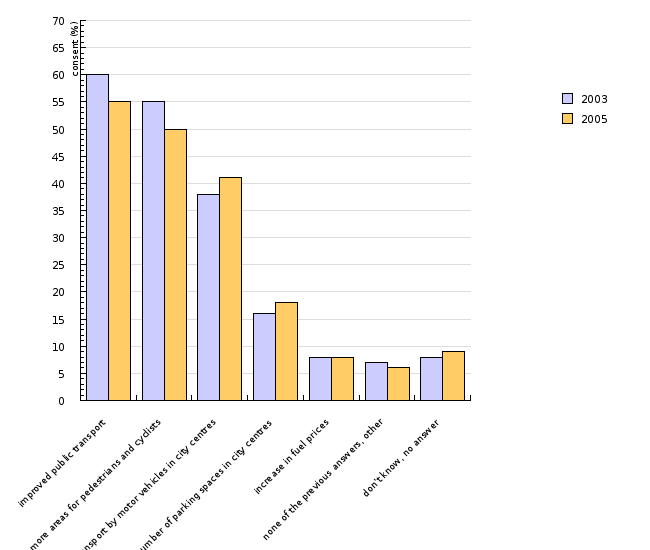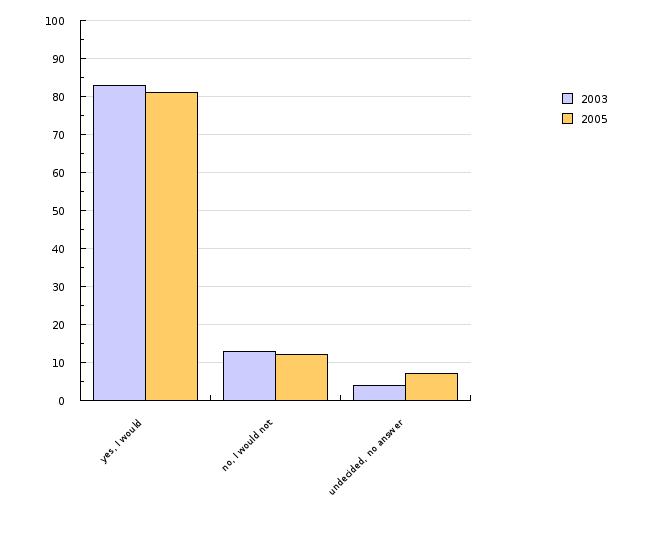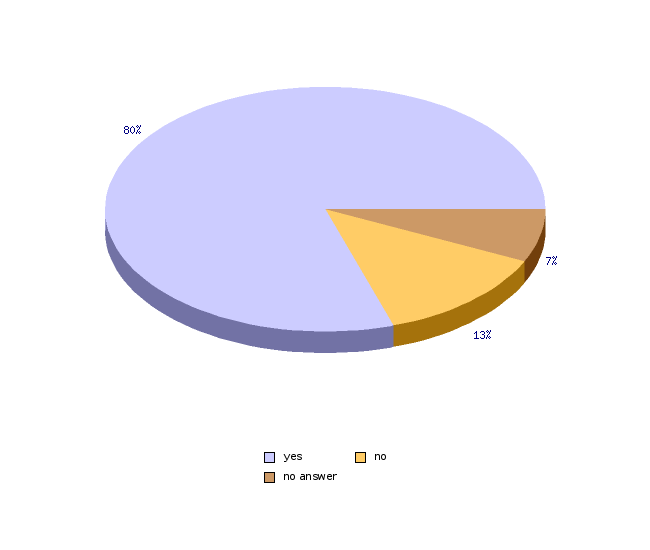[PR06] Public awareness about the effects of transport on the environment

Key message

Residents of Slovenia are aware of the problem of increasing traffic and its consequences for the environment. Public awareness has been increasing; however, it is not always reflected in a behaviour change of the population.
Definition
The indicator shows the attitude of the public towards environmental problems caused by transport. It is based on the results of a public opinion poll in 2003 and 2005, which also tried to determine the level of environmental concern of residents of Slovenia, their attitude towards possible measures for the elimination of environmental problems in urban transport, the level of use of passenger cars, the readiness for a change of travel habits and attitude towards the data on the emissions of new passenger cars at the time of purchase.
Charts
Politbarometer public opinion survey 1/2005. University of Ljubljana, Faculty of Social Sciences, Public Opinion and Mass Communication Centre, 2005.
| improved public transport | more areas for pedestrians and cyclists | prohibition of transport by motor vehicles in city centres | reduction of the number of parking spaces in city centres | increase in fuel prices | none of the previous answers, other | don’t know, no answer | ||
|---|---|---|---|---|---|---|---|---|
| 2003 | % | 60 | 55 | 38 | 16 | 8 | 7 | 8 |
| 2005 | % | 55 | 50 | 41 | 18 | 8 | 6 | 9 |
Politbarometer public opinion survey 1/2005. University of Ljubljana, Faculty of Social Sciences, Public Opinion and Mass Communication Centre, 2005.
| yes, I would | no, I would not | undecided, no answer | ||
|---|---|---|---|---|
| 2003 | % | 83 | 13 | 4 |
| 2005 | % | 81 | 12 | 7 |
Politbarometer public opinion survey 1/2005. University of Ljubljana, Faculty of Social Sciences, Public Opinion and Mass Communication Centre, 2005.
| yes | no | no answer | ||
|---|---|---|---|---|
| 2003 | % | 56 | 43 | 1 |
| 2005 | % | 61 | 37 | 2 |
Politbarometer public opinion survey 1/2005. University of Ljubljana, Faculty of Social Sciences, Public Opinion and Mass Communication Centre, 2005.
| yes | no | no answer | ||
|---|---|---|---|---|
| % | 80 | 13 | 7 |
Goals
- Awareness and informing of the population on sustainable mobility (RePPRS)
- Increase in the use of alternative transport modes and more responsible use of passenger cars (Operational Programme of Environmental and Transport Infrastructure Development for the Period 2007–2013)
- Education of passengers for the development and use of intermodal passenger transport (Operational Programme of Environmental and Transport Infrastructure Development for the Period 2007–2013)
Comment
The results of the research indicate that the residents of Slovenia are aware of the environmental consequences due to increasing traffic. The concern of the persons interviewed for the environmental problems is quite high; in general, the concern of all persons interviewed increased in all areas in comparison with 2003. The residents indicated that air pollution and traffic growth are the environmental problems about which they are the most concerned about. Noise is ranked last among the considered environmental problems.
The persons interviewed were asked about their proposals for solving environmental problems with regard to transport. Each person interviewed could provide two answers. In both time sections, the majority of persons interviewed thought that better public transport and more facilities for pedestrians and cyclists would contribute a lot to the solving of environmental problems; only a few persons interviewed proposed a fuel price increase.
A large majority of persons interviewed recommended better public transport in order to solve the environmental problems in urban areas. Therefore, it comes as no surprise that 81 % of the persons interviewed stated that with more frequent, cheaper and more comfortable public transport they would be willing to change their habits and use public transport on a daily basis.
61 % of the persons interviewed use passenger cars for their daily needs; however, 80 % of these drivers would be willing to use public transport, if it was properly organised.
When purchasing a new car, the persons interviewed also showed their engagement in environmental protection. 80 % claimed that the data on gas emissions, harmful to the environment, would be relevant when purchasing a new car. However, the authors of the research warn against the fact that this might also be a result of the good intentions of the persons interviewed (their wish to express ecological awareness that is considered as a general social norm) and not their actual practice or serious criterion when purchasing a new car.
According to the data of the European Environment Agency, concern for the environmental effects of transport is significant. The main perceived problems that are transport-related are the amount of traffic, air pollution and, to a lesser extent, damage to the landscape and noise; however, the percentage of people complaining about the latter has been decreasing (assessment for 1992–2002). The measure regarded by the public as the most effective for solving urban transport problems are improvements in public transport and better facilities for pedestrians and cyclists. Pricing measures (more expensive fuels) did not get a lot of public support (EEA, 2004). These public opinion conclusions are similar to the data of the Slovenian research study.
It has to be emphasized that the public awareness about environmental problems of transport does not lead automatically to a change in behavioural habits; the provision of information and awareness may assist behavioural change with regard to sustainable mobility. The Resolution on National Environmental Action Plan (2006) already exposed in its principles and strategic guidelines the importance of environmental awareness and dialogue with all interested parties as well as public participation. These principles are based on the Aarhus Convention and EU Directives referring to the right to public access to information, public participation in decision-making and access to justice. The plans in the area of public awareness are specified in detail in the chapter on communication and education. Environmental awareness and awareness about our common responsibility for the environment as well as encouragement of the readiness to change the system of values and lifestyle of all residents of Slovenia is defined as one of the measures in order to achieve the objectives of sustainable development. Environmental and ethical awareness, the development of values and changes in habits should be strengthened through communication channels, tools and activities. As a specific objective in the area of transport, the resolution has exposed the activities for the increase of the use of alternative mobility modes and more responsible use of cars. The measures to enable the attainment of objectives include cooperation and encouragement of municipalities for the promotion of sustainable transport and awareness about the effects of car usage, including priority alternative transport modes.
The objectives in the area of passenger transport in the Resolution on Transport Policy of the Republic of Slovenia (2006) stand for a change in travel habits, but they expose only urban areas. Local authorities should implement measures for the promotion of walking, cycling and public transport, including an increase of public environmental awareness. Public awareness is included also in the general measures of the transport policy stipulating education and schooling, informing and marketing, which would stimulate the awareness of the public about the importance of the transport system, its functioning and the optimum use of the transport infrastructure.
In Slovenia and in the majority of other European countries, an annual awareness campaign »In town without my car!« has been conducted since 2000, expanding into the initiative European Mobility Week. The main purpose of both campaigns has been primarily to facilitate the implementation of sustainable measures and solutions for a decrease in the overuse of passenger cars.
Besides the indicated activities, in the area of providing information the Rules on consumer information on fuel economy and CO2 emissions in respect of new passenger cars (2003), which entered into force at the beginning of 2004, have to be mentioned. Among other things, the Rules also stipulate a preparation of a manual on fuel economy and CO2 emissions.
Methodology
Data for Slovenia
Objectives summarised by: Resolution on Transport Policy of the Republic of Slovenia (RePPRS), OG RS, no. 58/2006 and Operational Programme of Environmental and Transport Infrastructure Development for the Period 2007–2013.
Source database or source: Politbarometer public opinion survey 1/2005.
Data administrator: University of Ljubljana, Faculty of Social Sciences, Public Opinion and Mass Communication Centre (CJM).
Date of acquisition for this indicator: 31 March 2006
Methodology and frequency of data collection for the indicator: The indicator was prepared on the basis of a Politbarometer public opinion survey (November 2003 and January 2005). It included three substantive sets, namely: 1. detection and assessment of the concern for each of the indicated environmental problems or phenomena, including the increase in car transport; 2. identification of the methods for solving environmental impacts of car transport in Slovenian towns; 3. assessment of readiness for the use of public transport modes (in connection with the assessment of the use of passenger cars as a daily transport mode). For the preparation of the questionnaire we used the public opinion study Eurobarometer from 1999 (requested by the European Commission), used also as a data source for the preparation of the environmental indicator TERM (Transport and Environment reporting mechanism for the EU) – Public awareness and behaviour – by the European Environment Agency (EEA, 2004).
Data processing methodology: /
Information concerning data quality:
- Advantages and disadvantages (at data level): The indicator is defined by quality data, comparable at the European level. However, the data is based only on two research studies; therefore, a longer time series does not exist.
- Relevance, accuracy, robustness, uncertainty:
Reliability of the indicator (archive data): The data refers only to 2003 and 2005.
Uncertainty of the indicator (scenarios/projections): Projections have not been prepared.
- Overall assessment (1 = no major comments, 3 = data to be considered with reservation):
Relevance: 1
Accuracy: 1
Completeness over time: 3 (the data refers only to 2003 and 2005)
Completeness over space: 1
Other sources and literature:
- EEA, 2004. TERM 2004 40 – Public awareness and behaviour. Indicator Fact Sheet. European Environment Agency (31 March 2006).
- Rules on consumer information on fuel economy and CO2 emissions in respect of new passenger cars. OG RS, no. 86/2003.
- Resolution on National Environmental Action Plan 2005–2012. OG RS, no. 2/2006.
- Resolution on Transport Policy of the Republic of Slovenia. OG RS, no. 58/2006.












